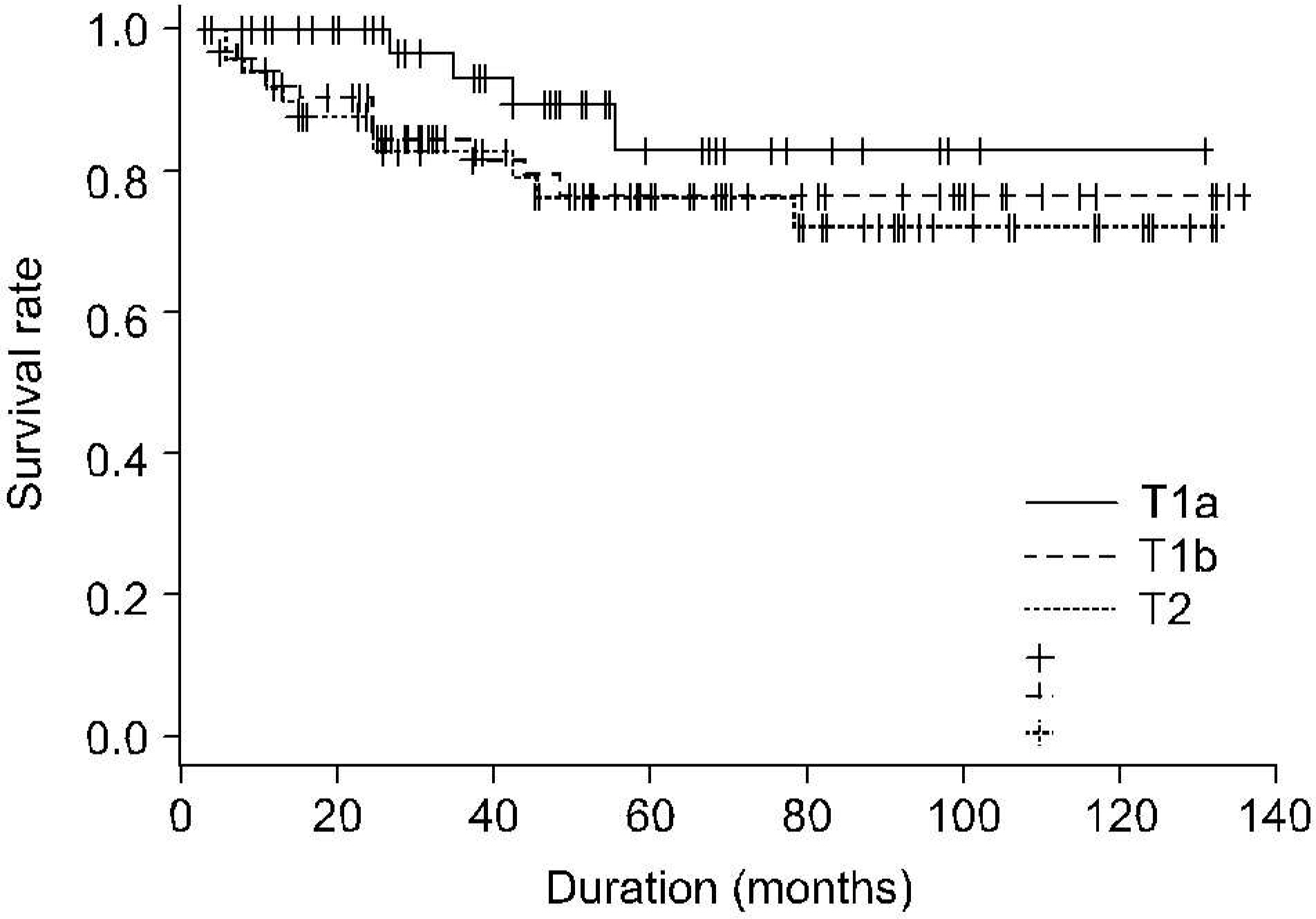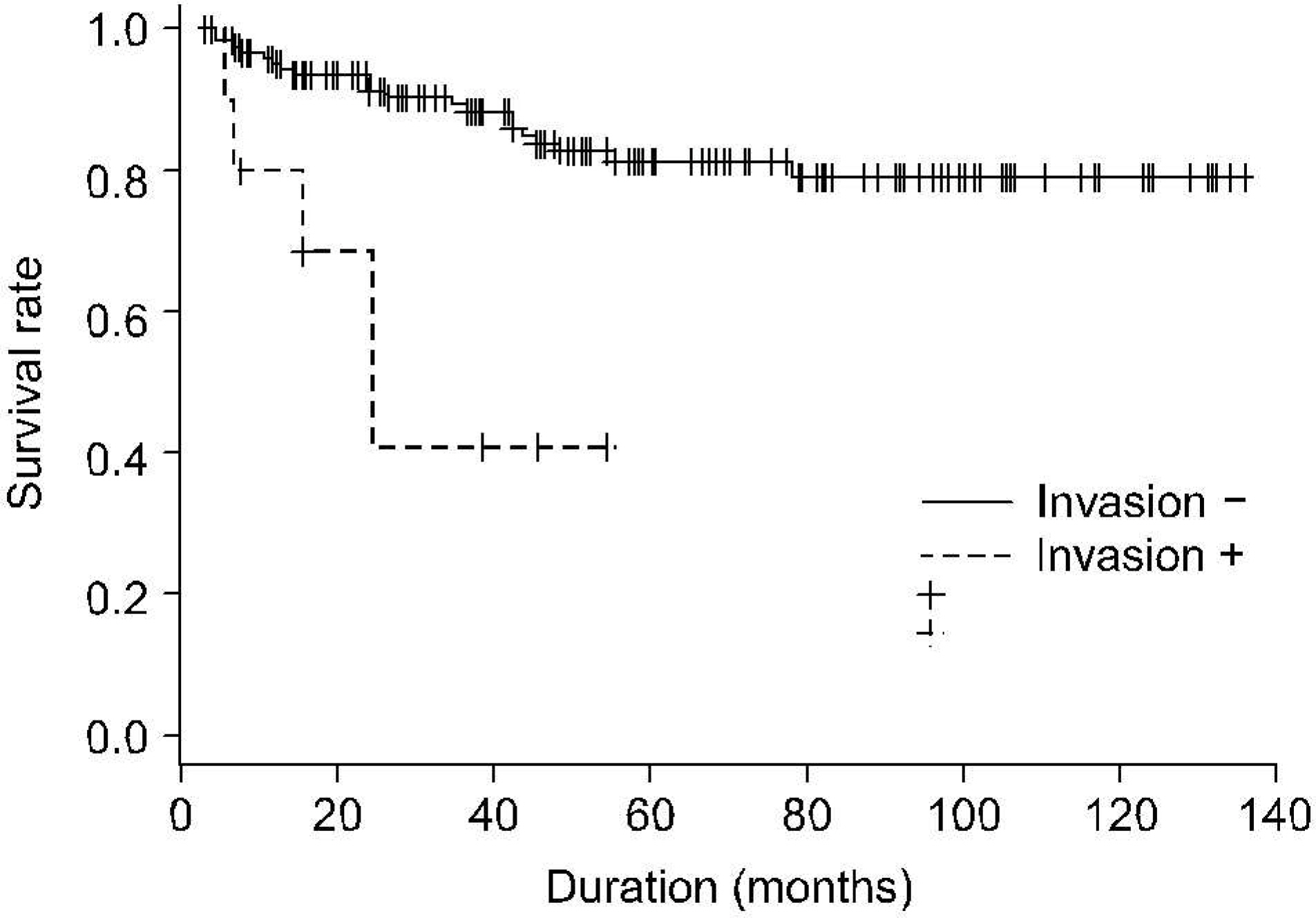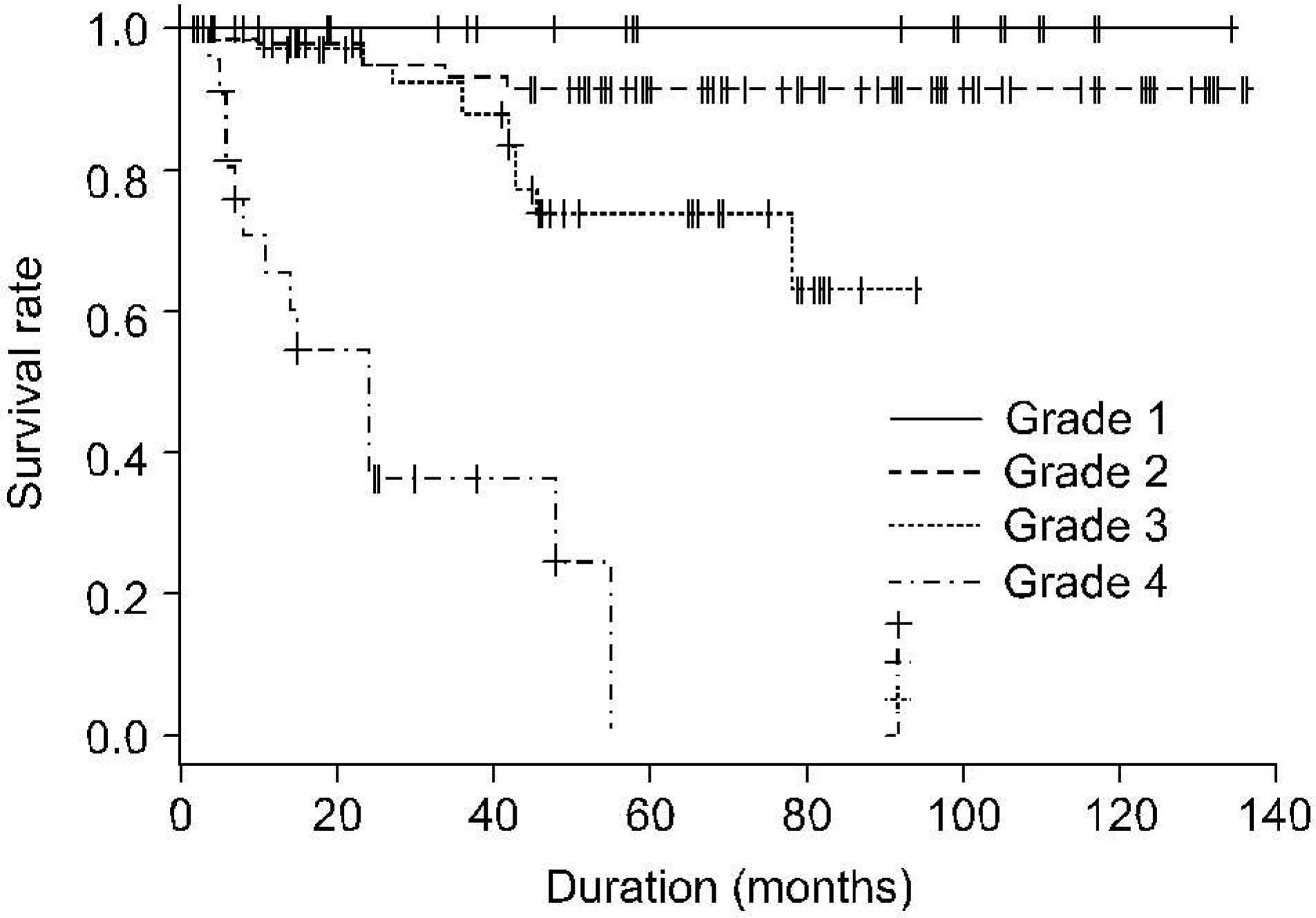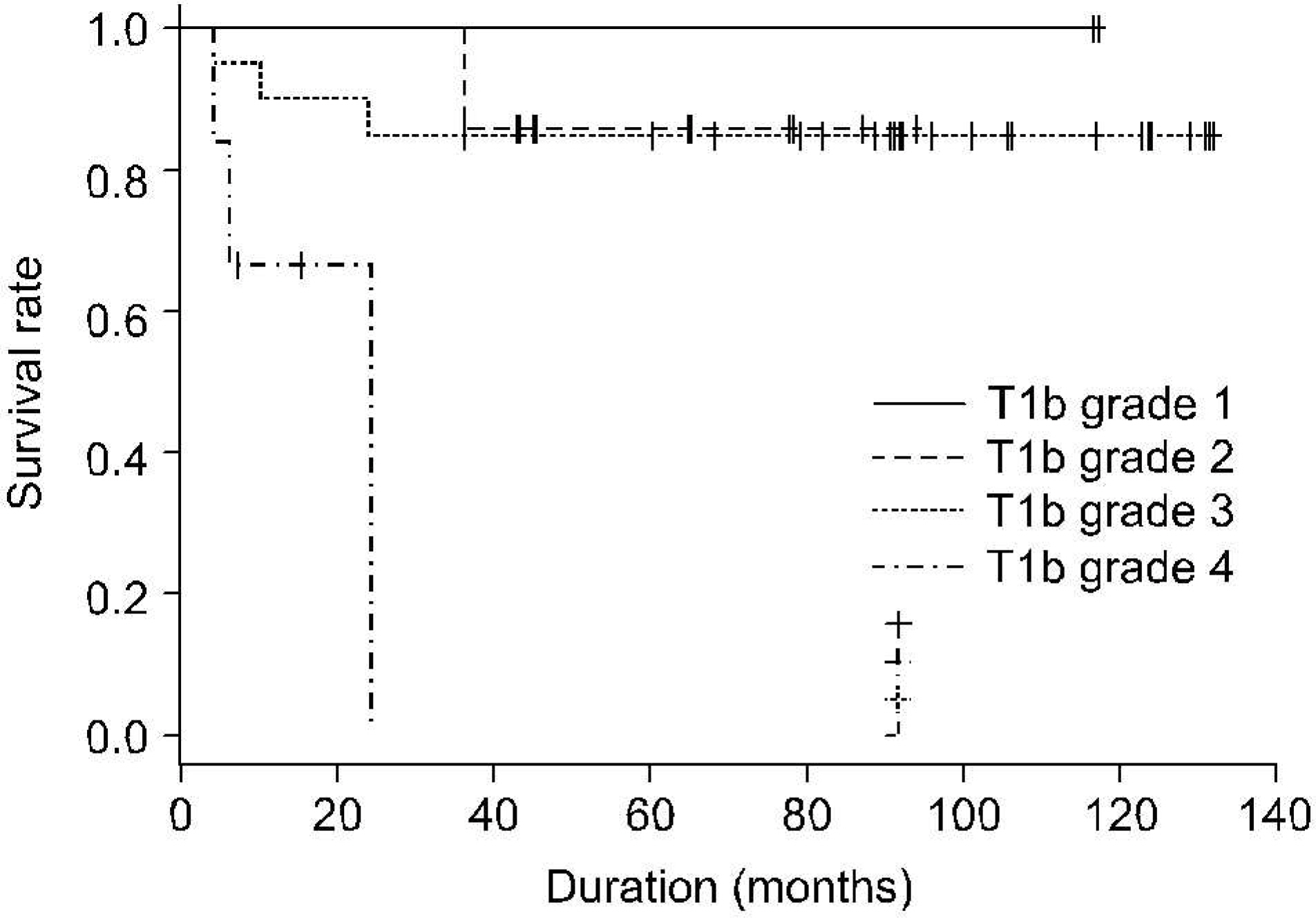Korean J Urol.
2007 May;48(5):471-476. 10.4111/kju.2007.48.5.471.
Significance of the Nuclear Grade as a Prognostic Factor for Patients with Localized Renal Cell Carcinoma
- Affiliations
-
- 1Department of Urology, Keimyung University School of Medicine, Daegu, Korea. cikim@dsmc.or.kr
- KMID: 2061249
- DOI: http://doi.org/10.4111/kju.2007.48.5.471
Abstract
-
PURPOSE: As the number of patients with localized renal cell carcinoma has increased, there are conflicting reports on the nuclear grade as a prognostic factor. The aim of this study was to evaluate the significance of the nuclear grade as a prognostic factor.
MATERIALS AND METHODS
We retrospectively enrolled 172 patients with localized renal cell carcinoma and who underwent radical nephrectomy. The patients were staged according to the 1997 TNM stage and the Fuhrman grading. The survival rate was analyzed by the Kaplan-Meier method. Multivariate analysis was performed using the Cox proportional hazard model.
RESULTS
The overall 1- , 5- and 10-year survival rates were 98.1, 72.5 and 68.4%, respectively. The 5-year survival rates for grades I, II, III and IV were 100, 92.6, 85.0 and 60.9%, respectively (p<0.0001). According to the Fuhrman grade in each T stage, 1) for patients with pT1b, the 5-year survival rates were 100, 85.0, 85.71 and 33.3% for patients with grade I, II, III and IV, respectively (p=0.002). 2) for patients with pT2, the 5-year survival rates were 100, 92.3, 60.0 and 25.0% for patients with grade I, II, III and IV, respectively (p<0.0001). A comparison of the survival curves by the Fuhrman grade showed a statistically significant difference.
CONCLUSIONS
The Fuhrman grade is an important prognostic factor for patients with localized renal cell carcinoma. A high nuclear grade tends to have metastatic potential and a poor prognosis. This group of patients with a high nuclear grade must be followed up more closely. Determining the pathologic stage along with using the Fuhrman grade-based surveillance protocols are a logical approach to follow-up.
MeSH Terms
Figure
Reference
-
1.Chow WH., Devesa SS., Warren JL., Fraumeni JF Jr. Rising incidence of renal cell carcinoma in the United States. JAMA. 1999. 281:1628–31.2.Kim WJ., Chung JI., Hong JH., Kim CS., Jung SI., Yoon DK. Epidemiologic study for urologic cancer in Korea (1998-2002). Korean J Urol. 2004. 45:1081–8.3.Parsons JK., Schoenberg MS., Carter HB. Incidental renal tumor: casting doubt on the efficacy of early intervention. Urology. 2001. 57:1013–5.4.Lee HW., Cho KS., Jeong H., Yoon SJ., Jo MK., Lee ES. Clinical analysis of incidentally found renal cell carcinoma: experiences of recent 8 years. Korean J Urol. 1998. 39:982–7.5.Thrasher JB., Paulson DF. Prognostic factors in renal cancer. Urol Clin North Am. 1993. 20:247–62.
Article6.Siminovitch JM., Montie JE., Stra伴on RA. Prognostic indicators in renal adenocarcinoma. J Urol. 1983. 130:20–3.
Article7.Tsui KH., Shvarts O., Smith RB., Figlin RA., DeKemion JB., Belldegrun A. Prognostic indicators for renal cell carcinoma: a multivariate analysis of 643 patients using the revised 1997 TNM staging criteria. J Urol. 2000. 163:1090–5.
Article8.Minervini R., Minervini A., Fontana N., Traversi C., Cristofani R. Evaluation of the 1997 tumour, nodes and metastases classification of renal cell carcinoma: experience in 172 patients. BJU Int. 2000. 86:199–202.
Article9.Siminovitch JM., Montie JE., Stra伴on RA. Prognostic indicators in renal adenocarcinoma. J Urol. 1983. 130:20–3.
Article10.Strohmeyer T., Ackermann R. Classic and modem prognostic indicators in renal cell carcinoma. Review of die literature. Urol Int. 1991. 47:203–12.11.Goldstein NS. Grading of renal cell carcinoma. Urol Clin North Am. 1999. 26:637–42.
Article12.Medeiros LJ., Gelb AB., Weiss LM. Renal cell carcinoma. Prognostic significance of morphologic parameters in 121 cases. Cancer. 1988. 61:1639–51.13.Gelb AB., Shibuya RB., Weiss LM., Medeiros LJ. Stage I renal cell carcinoma. A clinicopadiologic study of 82 cases. Am J Surg Padiol. 1993. 17:275–86.14.Greene FL., Page DL., Fleming ID., Fritz A., Balch CM., Haller DG, et al. AJCC cancer staging manual. 6th ed.New York: Springer-Verlag;2002. ;323-8.15.Fuhrman SA., Lasky LC., Limas C. Prognostic significance of morphologic parameters in renal cell carcinoma. Am J Surg Pathol. 1982. 6:655–63.
Article16.Luciani LG., Cestari R., Tallarigo C. Incidental renal cell carcinoma-age and stage characterization and clinical implications: study of 1, 092 patients (1982-1997). Urology. 2000. 56:58–62.17.Ljungberg B., Grankvist K., Rasmuson T. Serum interleukin-6 in relation to acute-phase reactants and survival in patients with renal cell carcinoma. Eur J Cancer. 1997. 33:1794–8.
Article18.Masuda H., Kuria Y., Suzuki K., Fujita K., Aso Y. Predictive value of serum immunosuppressive acidic protein for staging renal cell carcinoma: comparison with other tumour markers. Br J Urol. 1997. 80:25–9.
Article19.Nativ O., Sabo E., Raviv G., Medalia O., Moskovitz B., Gold-wasser B. The role of nuclear morphometry for predicting disease outcome in patients with localized renal cell carcinoma. Cancer. 1995. 76:1440–4.
Article20.Kim DS., Woo YN., Lee TY. The value of tumor size as a prognostic factor in patients with localized renal cell carcinomas. Korean J Urol. 2002. 43:813–7.21.Chang SG., Yi JW., Kim YJ., Kim YW. The prognostic factors influencing the survival rate in patients with localized renal cell carcinoma. Korean J Urol. 2004. 45:872–7.22.Mrstik C., Salamon J., Weber R., Stogermayer F. Microscopic venous infiltration as a predictor of relapse in renal cell carcinoma. J Urol. 1992. 148:271–4.23.Van Poppel Η., Vandendriessche H., Boel K., Mertens V., Goe-thuys H., Haustermans K, et al. Microscopic vascular invasion is the most relevant prognosticator after radical nephrectomy for clinically nonmetastatic renal cell carcinoma. J Urol. 1997. 158:45–9.
Article24.Skinner DG., Colvin RB., Vermilion CD., Pfister RC., Leadbetter WF. Diagnosis and management of renal cell carcinoma: a clinical and pathological study of 309 cases. Cancer. 1971. 28:1165–77.25.Cheon SY., Doo HW., Kim HJ., Lee DG. Influence of nuclear grade on prognosis in patients with renal cell carcinoma treated by radical nephrectomy. Korean J Urol. 2003. 44:838–43.26.Minervini A., Lilas L., Minervini R., Selli C. Prognostic value of nuclear grading in patients with intracapsular (pTl-pT2) renal cell carcinoma. Long-term analysis in 213 patients. Cancer. 2002. 94:2590–5.27.Lee U., Kim KR., Ahn HJ. The prognostic value of Fuhrman nuclear grade, 1997 TNM classification and cell type in renal cell carcinoma. Korean J Urol. 2001. 42:32–9.28.NCCN Clinical Practice Guide lines in Oncology. Kidney Cancer Version 2. National Comprehensive Cancer network. 2005.29.Mickisch G., Carballido J., Hellsten S., Schulze H., Mensink H. European Association of Urology. Guidelines on renal cell cancer. Eur Urol. 2001. 40:252–5.30.Korean Urological Oncology Society. Guidelines for renal cell carcinoma. 1st ed.Seoul: Medrang Inforang;2003. p. 58–67.
- Full Text Links
- Actions
-
Cited
- CITED
-
- Close
- Share
- Similar articles
-
- Prognostic Value of Pathological Parameters in Renal Cell Carcinoma
- Correlation of Clinical Stage and Presumptive Prognostic Factors in Renal Cell Carcinoma
- Prognostic Implication of p53 Immunohistochemical Staining in Patients with Localized Renal Cell Carcinoma after Radical Nephrectomy
- The Prognostic Value of Fuhrman Nuclear Grade, 1997 TNM Classification and cell Type in Renal Cell Carcinoma
- The Prognostic Value of Tumor Angiogenesis, Hepatocyte Growth Factor and c-met Expression in Renal Cell Carcinoma






